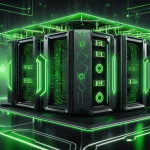Nvidia’s Jensen Huang Backs Musk’s Optimus as Trillion-Dollar Game-Changer for Crypto and AI

Nvidia’s Jensen Huang Champions Elon Musk’s Optimus Robot as a Trillion-Dollar Frontier with Crypto Ripples
Nvidia CEO Jensen Huang has ignited headlines with a audacious claim: Elon Musk’s humanoid robot, Optimus, could spearhead a multi-trillion-dollar industry. With Nvidia’s latest earnings shattering expectations at $44.06 billion in revenue, driven by explosive AI demand, Huang’s vision carries serious clout. Beyond the tech hype, this story reverberates into the Bitcoin and crypto space, where computational power and decentralized innovation intersect with AI and robotics in ways that could redefine our financial future.
- Optimus Ambition: Huang predicts Musk’s robot could unlock a multi-trillion-dollar market.
- Nvidia’s Powerhouse: $44.06 billion revenue, fueled by 73% data center growth, despite an $8 billion hit from China export bans.
- Crypto Nexus: AI and robotics advances could supercharge blockchain infrastructure and decentralized systems.
Nvidia’s Financial Might: AI as the New Gold Rush
Nvidia’s latest quarterly results are nothing short of staggering. Raking in $44.06 billion in revenue, the chip giant blew past Wall Street’s $43.31 billion forecast, posting adjusted earnings per share of $0.96 against an expected $0.93. The engine behind this surge? A jaw-dropping 73% year-over-year growth in their data center business, catering to the insatiable hunger for AI technologies like generative models—think tools like ChatGPT or xAI’s Grok chatbot. Huang didn’t mince words about the frenzy, noting the demand is “just off the charts.” Investors agreed, pushing Nvidia’s stock up 6% in after-hours trading, eyeing an opening price of $143.23 after closing at $134.81, marking a 23% climb in a single month.
For the uninitiated, data centers are massive hubs of computing power, packed with servers that process everything from cloud services to AI training. Nvidia’s dominance here isn’t just a tech win—it’s the kind of raw horsepower that blockchain networks lean on for scalability. While Bitcoin mining has largely moved to specialized gear called ASICs (Application-Specific Integrated Circuits, custom-built for crunching Bitcoin’s math puzzles), Nvidia’s GPUs (Graphics Processing Units, versatile chips originally for gaming but now pivotal for complex computations) still play a role in altcoin mining and decentralized computing projects. This financial flex signals Nvidia’s capacity to fuel the next wave of crypto innovation, even as challenges loom large.
Geopolitical Storms: Centralized Risks Hit Hard
Not everything is coming up roses for Nvidia. U.S. export controls on advanced chips to China delivered an $8 billion revenue sucker punch, effectively slamming the door on a $50 billion AI chip market. Huang was blunt about the stakes: China, the second-largest AI market with a vast talent pool, is now a walled garden for domestic giants like Huawei, who are rapidly developing rival tech. His take? It’s sensible for Chinese firms to build on Huawei’s stack, but dismissing American innovation would be a colossal misstep. “If able to compete, American companies will win,” he asserted, blending realism with a fighter’s grit.
“It’s prudent for Chinese customers to develop their stack on Huawei, but to write off American technology companies is not smart. If able to compete, American companies will win.” – Jensen Huang on the competitive landscape in China’s AI market.
This isn’t just Nvidia’s headache—it’s a glaring red flag for the crypto world. Centralized supply chains for cutting-edge tech, whether AI chips or mining hardware, can be throttled overnight by geopolitical chess games. Remember the 2021 Bitcoin mining crackdown in China? Rig shortages and skyrocketing costs crippled miners globally. If a trade spat can cost Nvidia $8 billion, as seen in recent export control impacts, imagine the ripple effect on sourcing the latest GPUs or ASICs for your mining operation. Costs spike, delays drag, and suddenly, your decentralized dream is hostage to centralized nonsense—the exact crap Bitcoin was built to bypass. Huang’s support for U.S. tariffs and reshoring manufacturing, which he dubbed a “transformative idea,” aligns with crypto’s ethos of dodging middlemen, but it also hints at a fragmented tech future where access isn’t guaranteed.
Nvidia’s Strategic Plays: Musk, AI, and Global Moves
Amidst these headwinds, Nvidia isn’t sitting idle. Huang doubled down on partnerships with Elon Musk’s ventures, praising him as an “extraordinary engineer” and committing to “build many more computers together.” Nvidia’s collaboration with Tesla on self-driving tech and xAI on projects like the Grok chatbot positions them at the heart of AI-driven innovation, as highlighted in their ongoing partnership. Then there’s Optimus, Tesla’s humanoid robot designed to tackle repetitive labor tasks across industries like manufacturing and logistics. Huang’s bold call on its multi-trillion-dollar potential isn’t idle chatter—it’s backed by Musk’s history of turning wild ideas into world-changers.
“Likely the next multi-trillion dollar industry.” – Jensen Huang on Elon Musk’s Optimus robot and its economic potential.
Beyond Musk, Nvidia is eyeing global expansion, planning a multi-country tour across France, the UK, Germany, and Belgium to establish national AI infrastructure—think “AI factories” to power local tech ecosystems. This diversification, paired with Huang’s backing of U.S. policies to bolster domestic AI leadership, shows a company navigating trade wars with calculated moves. For crypto enthusiasts, this raises a question: could Nvidia’s sprawling compute power and futuristic projects like Optimus intersect with our push for decentralization in ways we’re only beginning to grasp, as explored in discussions on tech influence?
Crypto Connections: Nvidia’s Compute Power Meets Blockchain
Let’s cut to why this matters for Bitcoin and blockchain. Nvidia’s historical footprint in crypto is undeniable—during the 2017-2018 boom, their GPUs were the go-to for mining Ethereum and other Proof-of-Work coins before ASICs took over Bitcoin’s domain. Even post-Ethereum’s merge to Proof-of-Stake in 2022, GPUs remain relevant for mining altcoins like Ravencoin or Ergo. More critically, Nvidia’s data center surge supports the cloud infrastructure that blockchain projects rely on for scalability—think distributed ledger systems needing serious computational grunt to process transactions or train AI models.
Look at projects like Render Token or Golem, which harness GPU power for decentralized computing tasks, from rendering graphics to crunching data. Or consider Ocean Protocol and Fetch.ai, blending AI with blockchain to create decentralized markets for data and machine learning. Nvidia’s chips are often the silent engine behind these innovations, and their AI boom could turbocharge the next generation of smart contracts or decentralized apps. For Bitcoin maximalists, the takeaway might be simpler: while BTC’s mining stays ASIC-focused, the broader ecosystem of decentralized tech still benefits from Nvidia’s growth, even if indirectly, as seen in Huang’s broader vision for AI industries. Bitcoin’s simplicity—needing less flashy tech than altcoin platforms—might just be its shield against supply chain chaos.
But let’s not get too cozy. Relying on a titan like Nvidia for compute power risks swapping one centralization trap for another. If their chips become the backbone of decentralized AI or blockchain scaling, what happens when geopolitical bans or corporate decisions choke access? Crypto’s ethos of freedom and privacy demands we stay vigilant—maybe it’s time for community-driven hardware initiatives or open-source alternatives to keep power in the people’s hands, not Silicon Valley’s.
Future Speculations: Optimus and the Decentralized Horizon
Now for the fun, slightly unhinged bit: could something like Optimus play a role in crypto’s physical infrastructure? Picture this—humanoid robots automating the security of remote Bitcoin mining farms, monitoring hardware, or even acting as autonomous nodes in far-flung networks. It sounds like sci-fi fever dream, but with Musk’s knack for execution and Nvidia’s tech backing, dismissing it feels as naive as laughing off Bitcoin at $1. Automation could slash human error and costs in managing sprawling mining operations, especially in hostile or hard-to-reach areas. Tie that to blockchain-secured IoT systems for real-time oversight, and you’ve got a glimpse of a hyper-decentralized future, a concept gaining traction in recent updates on Optimus development.
Before we get carried away, let’s ground this. The cost of deploying robots like Optimus would be astronomical, and scalability for niche use cases like mining security is questionable. Plus, there’s the ethical quagmire—do we really want critical crypto infrastructure in the hands of AI-driven machines, potentially creating new centralization risks if tech giants control the tech? And let’s be real: Bitcoin’s resilience doesn’t need robots to keep humming; it’s survived worse than a lack of cyborg guards. Still, the convergence of AI, robotics, and blockchain sparks ideas worth chewing on, especially for altcoin ecosystems hungry for innovation, as noted by Huang’s bold predictions.
Key Questions and Takeaways for Crypto Enthusiasts
- How does Nvidia’s AI dominance impact Bitcoin and crypto mining?
While Bitcoin mining relies on ASICs, Nvidia’s GPUs still power altcoin mining, and their data center growth fuels cloud infrastructure for blockchain scalability, supporting decentralized networks’ expansion. - What could Elon Musk’s Optimus mean for decentralized technology?
Though speculative, Optimus could inspire automation in managing physical crypto assets like mining farms, potentially cutting costs and boosting security, though practical and ethical hurdles remain. - Do U.S. export controls pose a threat to crypto hardware access?
Hell yes—centralized supply chain disruptions, as seen with Nvidia’s $8 billion loss, could spike costs or delay access to mining rigs and chips, highlighting the urgency for decentralized hardware solutions. - Can Nvidia’s partnerships with Tesla and xAI drive blockchain innovation?
Definitely—their focus on AI and robotics could accelerate decentralized AI platforms on blockchain, merging raw compute power with crypto’s mission of freedom from centralized control. - Why should crypto folks care about Nvidia’s geopolitical challenges?
Trade wars and bans risk fracturing tech access, potentially slowing innovation or jacking up costs for hardware vital to blockchain and mining, pushing us to outmaneuver centralized dependencies. - Is there a risk of new centralization from relying on Nvidia’s tech?
Absolutely—leaning on a giant like Nvidia for decentralized projects could create fresh choke points, urging the crypto community to explore alternative hardware and keep power distributed.
Nvidia, under Huang’s bold leadership, is surfing an AI tsunami with implications that ripple into the crypto realm. From raw computing muscle to futuristic automation with Optimus, the potential to amplify blockchain and decentralized systems is real—but so are the risks of centralized pitfalls and geopolitical quicksand. Bitcoin’s rugged simplicity might weather these storms best, yet altcoin and blockchain innovators stand to gain (or lose) big from Nvidia’s trajectory, guided by visionaries like Jensen Huang. One thing’s clear: as tech giants and trade wars clash, crypto’s fight for sovereignty only gets fiercer. Will AI be our ally in smashing centralized shackles, or just a shinier cage? That’s the million—or trillion—dollar question.



